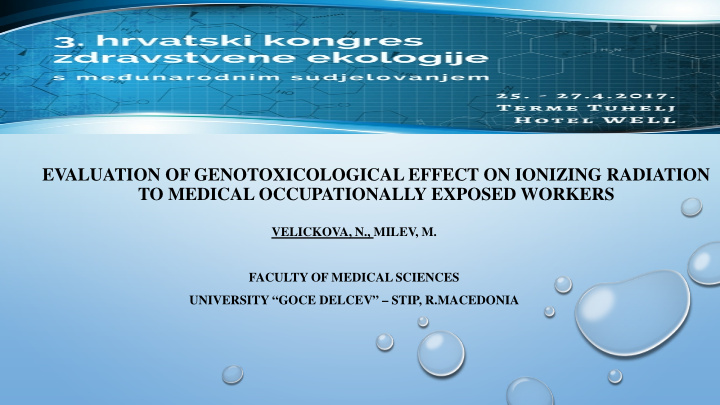



EVALUATION OF GENOTOXICOLOGICAL EFFECT ON IONIZING RADIATION TO MEDICAL OCCUPATIONALLY EXPOSED WORKERS VELICKOVA, N., MILEV, M. FACULTY OF MEDICAL SCIENCES UNIVERSITY “GOCE DELCEV” – STIP, R.MACEDONIA
Increase the risc of acrylamide, potential different organic health risk cancerous professionally solvents diseases compounds or incidentally number of elements HUMAN GENOTOXICANTS COME AS POLLUTANTS FROM TECHNOLOGICAL PROCESSES AND ARE ALSO A RESULT OF THE UNCONTROLLED MANUFACTURING OF CERTAIN CHEMICAL SUBSTANCES AND THEIR PRODUCTS
THE EFFECT ON EACH EXPOSED INDIVIDUAL DEPENDS OF genetically- determined differences among the the method individuals the degree of of exposure to a elimination given factor age sensitivity to its toxic effects
Cytogenetic monitoring chronic exposure of the organism to genotoxic agents induced small doses of chemical or physical mutations mutagens leads to potential genotoxicity chromosome mutagen effect: chromosome breakage and rearrangement
Comet assay is performed on individual cells in agarose gel used for rapid detection of any damage or repair in the DNA molecule. The short fragments travel faster through the gel due to the different molecular weight. These different fragments are stained with fluorescent colors and on fluorescent microscope are visible as comets
DIAGNOSTIC TOOL AND PROCEDURE FOR MEASURING MICRONUCLEUS FREQUENCY IN PERIPHERAL BLOOD LYMPHOCYTES • MICRONUCLEI ARE GENERATED AS A RESULT OF EXPOSURE OF THE BODY TO CLASTOGENIC AGENTS, ESPECIALLY THE IONIZING RADIATION MICRONUCLEI ARE INDEPENDENT CHROMATIN STRUCTURES • THAT ARE COMPLETELY SEPARATED FROM THE CORE • THEY ARE CREATED AS A RESULT OF CONDENSATION OF ACENTRIC CHROMOSOME FRAGMENTS OR WHOLE CHROMOSOMES THAT ARE LATE IN ANAPHASE • AVERAGE SIZE OF MICRONUCLEI MAY VARY FROM 1/3 OR 1/16 OF THE CELL SIZE • IMPORTANT QUANTITATIVE BIOMARKER WHICH PROVES THE EXISTENCE OF STRUCTURAL CHROMOSOMAL ABERRATIONS WHICH ARE THE RESULT OF DIFFERENT GENOTOXIC AGENTS IN VITRO OR IN VIVO CONDITIONS
to evaluate the genotoxicity abnormal nuclear of ionizing shapes (MNi), to radiation nucleoplasmic determine bridges (NPBs) the human and nuclear buds (NBUDs) AIMS health risk OF THE STUDY
• THE STUDY POPULATION INCLUDED: 20 INDIVIDUALS IN THE EXPOSED GROUP , MEDICAL PERSONNEL EXPOSED TO IONIZING • RADIATION (RADIOLOGIST, TECHNICIANS AND NURSES) 20 INDIVIDUALS IN THE CONTROL GROUP , HEALTHY PEOPLE, (WHO HAVE NEVER BEEN • EXPOSED TO IONIZING RAYS AND OTHER CHEMICAL OR PHYSICAL AGENTS). Exposed group Control group Number of men 13 10 Number of women 7 10 Age range 45±15 18±22 Range of years of professional exposure 15-35 / Smokers 13 7
Venous blood sample (3 ml) was collected in heparinized tubes. Blood culture protocol was done according to Fenech (2007). 0.5-ml of blood sample was added to the culture tubes containing 4.5 ml of RPMI 1640 media (enriched with 20% fetal bovine serum, L-glutamine and 0.2 ml of phytohemagglutinin 1 % and eachsupplemented with 100 units/mL penicillin and 100 µg/mL streptomycin. The tubes was incubated 44h at 37 °C. Cytochalasin B was then added to each culture to block cell cytokinesis and cultures were reincubated at 37 °C for further 28 h. Fixation Stained examined by light microscope Leica DM4500 P (×40 and×100)
Classified the cells as mononucleates, binucleates or multinucleate
1,000 BN cells were evaluated MNi are defined as small, round nuclei clearly separated from the main cell nucleus
SAMPLE EXPOSED GROUP CONTROL GROUP 1. M/F AGE PROFES.EXPOS S/NS MN M/F AGE S/NS MN 2. M 60 32 S 16 M 21 NS 5 3. M 51 24 S 12 M 19 NS 0 4. M 50 15 NS 5 M 27 S 4 5. F 59 35 S 18 M 18 NS 1 6. F 45 15 S 21 M 33 S 8 7. M 48 27 S 9 M 20 NS 2 8. M 46 18 NS 14 M 25 NS 3 9. M 45 17 NS 8 M 25 NS 2 10. F 57 33 S 19 M 21 S 0 11. M 45 16 NS 8 M 21 NS 2 12. F 55 31 S 17 F 31 NS 2 13. F 45 23 NS 21 F 28 NS 4 14. M 45 26 S 8 F 28 NS 5 15. F 60 35 S 18 F 28 S 3 16. M 58 24 S 16 F 32 S 11 17. M 46 16 S 19 F 18 NS 4 18. M 52 24 NS 11 F 20 NS 6 19. M 55 25 NS 6 F 32 S 9 20. M 59 32 S 23 F 24 NS 6 21. F 60 30 S 19 F 40 S 13 ∑ 289 90 Average (x) 14.5 4.5 STDV (s) 5,51 3,52 V (%) 38 07 78 15
BN cells containing NPB BN cells containing NBUDs
• MN-ASSEY IS ONE OF THE BIOMARKERS IN GENOTOXICOLOGY, FOR ASSESSING THE CHROMOSOMAL INSTABILITY AND DAMAGE IS SCORING OF MN FREQUENCY’S IN LYMPHOCYTES • THE MEAN OF MN FREQUENCIES IN THE EXPOSED GROUP IS GREATER IN COMPARISON WITH THE MEAN OF MN FREQUENCIES IN THE CONTROLLED GROUP • CHROMOSOMAL INSTABILITY IS IN CORRELATION WITH MN FREQUENCIES IN MEDICAL WORKERS EXPOSED TO IONIZING RADIATION • THE FORMATION OF SMALL AND LARGE MNI, NPBS, NBUDS ETC. INDICATES THAT MEDICAL WORKERS ARE EXPOSED ON CLASTOGENIC AND ANEUGENIC AGENTS, LIKE IONIZING RADIATION AND HAVE CHROMOSOMAL INSTABILITY AND HIGH RISK OF CANCER • STUDENT’S T-TEST SHOWED SIGNIFICANT STATISTICAL DIFFERENCES BETWEEN THE TOTAL NUMBER OF BN CELLS WITH MN WITHIN THE TWO GROUPS (THE EXPOSED AND THE CONTROL) (T=6,812; P<0,05).
THE NEED OF CYTOGENETIC MONITORING THE IMPORTANCE OF THE CHROMOSOMAL MUTAGENIC EFFECT, WHICH WE CAN ANALYZE CYTOLOGICALLY WITH GENOTOXIC TEST S MN-assey Comet assey
Recommend
More recommend